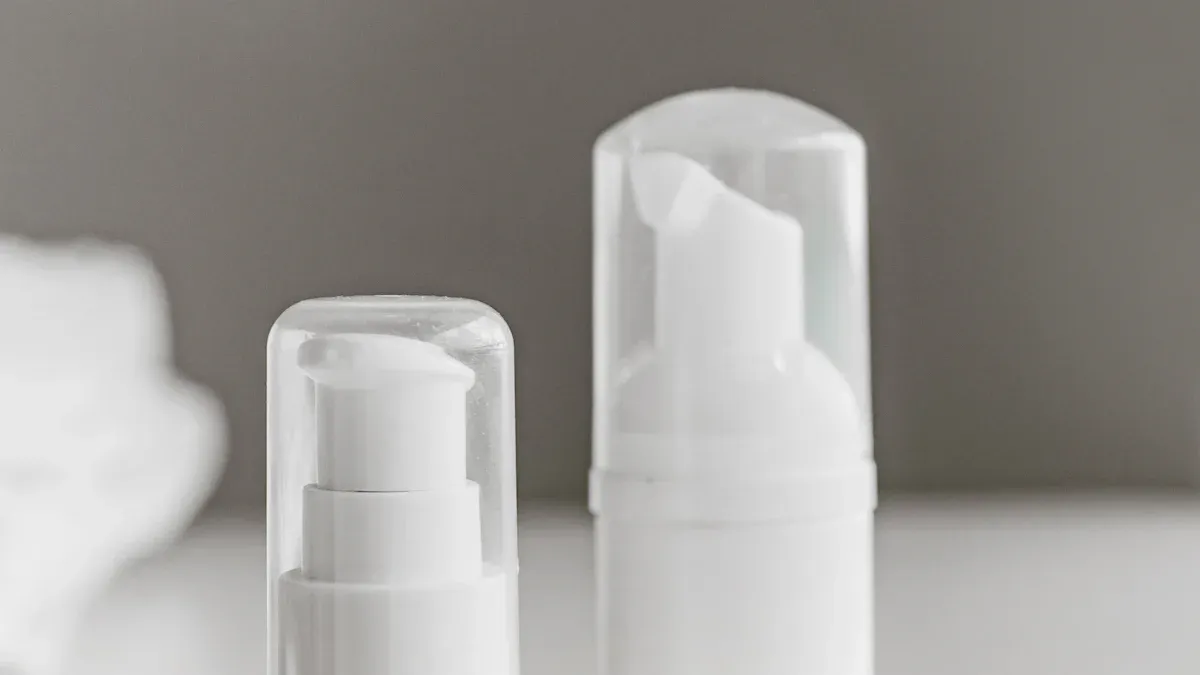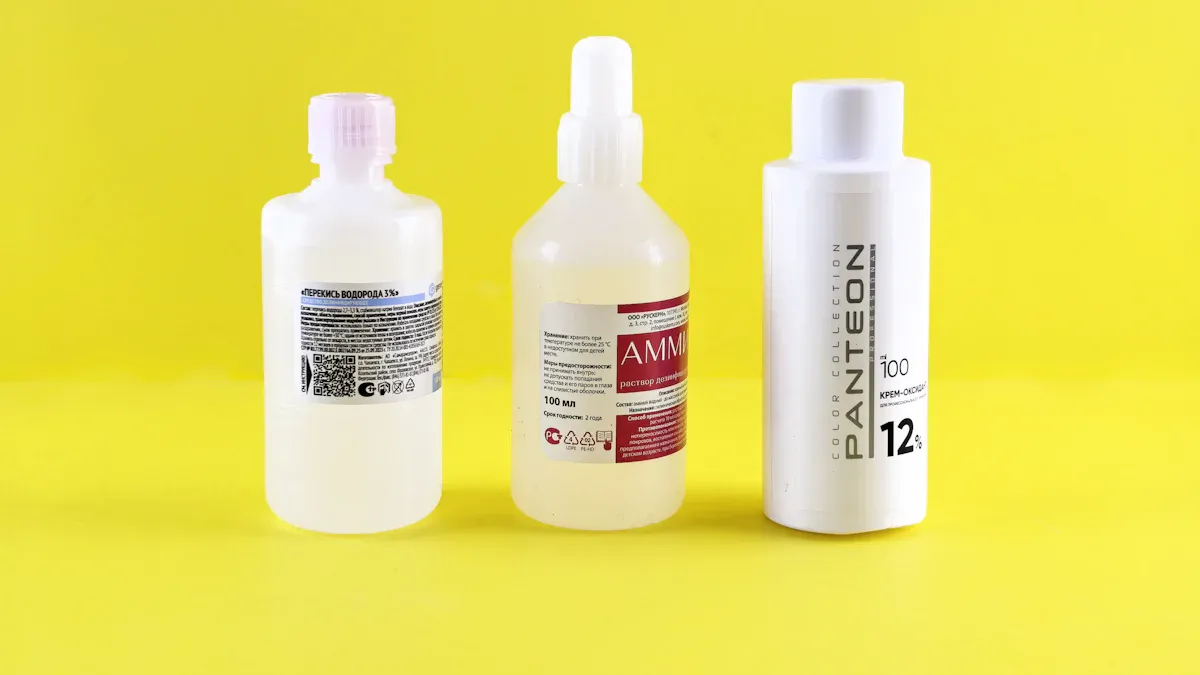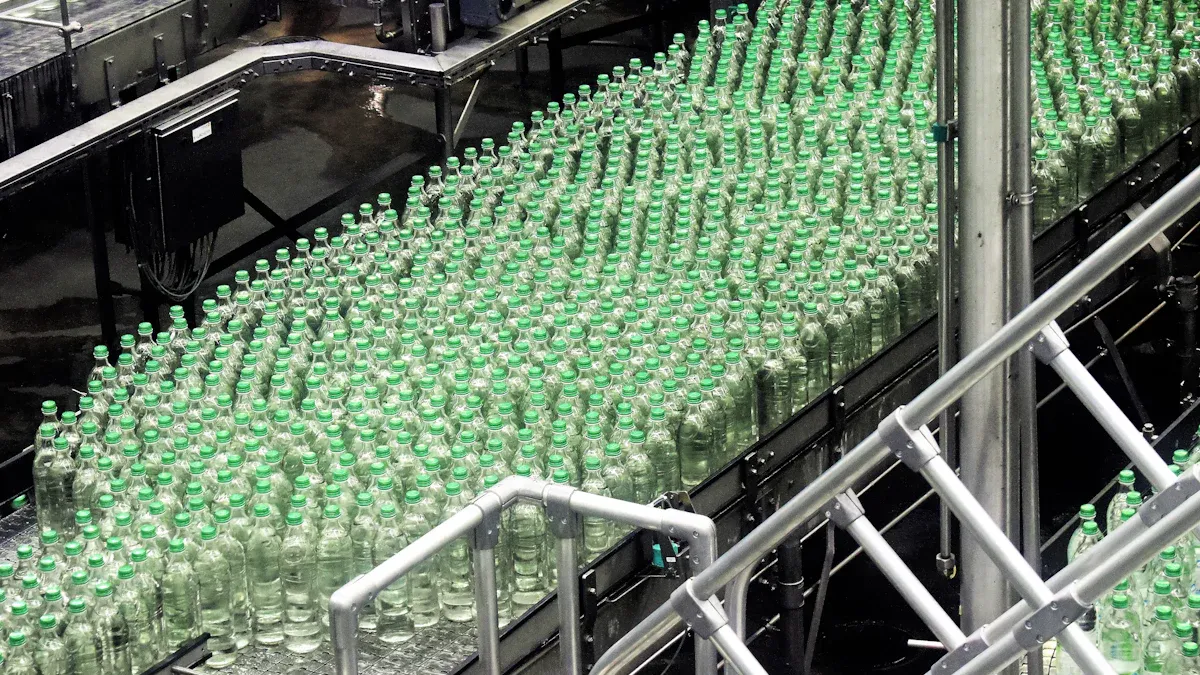Views: 0 Author: Site Editor Publish Time: 2025-07-30 Origin: Site
 Thin-gauge thermoforming is important in packaging. It gives easy and good solutions. This method uses thin-gauge plastic. The plastic makes packaging light, strong, and recyclable. Companies like thermoforming because it is fast. It does not cost much. It also lets them make many designs. Many things use thin-gauge packaging. Food containers and medical trays are some examples.
Thin-gauge thermoforming is important in packaging. It gives easy and good solutions. This method uses thin-gauge plastic. The plastic makes packaging light, strong, and recyclable. Companies like thermoforming because it is fast. It does not cost much. It also lets them make many designs. Many things use thin-gauge packaging. Food containers and medical trays are some examples.
It costs less and makes less waste than other ways
It is fast and good for making many items
It can be used for many different things
Thin-gauge thermoforming helps companies solve new packaging problems.
Thin-gauge thermoforming shapes thin plastic sheets fast. It makes packaging that is light, strong, and can be recycled.
This method saves money by using less material. It also cuts labor costs with machines. It makes shipping lighter and cheaper.
It gives lots of design choices. You can change designs quickly. You can make custom shapes for many products.
Thin-gauge packaging is used for food, medical, and other goods. It protects products well. It is also easy to recycle.
Thin-gauge thermoforming is faster than other ways. It costs less and is better for making lots of disposable packaging.
Thin gauge thermoforming shapes thin plastic sheets for packaging. Most sheets are between 0.010 and 0.080 inches thick. People often call this thin-gauge or light gauge thermoforming. These thin sheets are good for making things you throw away after use. The table below shows how thick the plastic is for different uses:
| Application Area | Typical Material Thickness Range (inches) | Notes on Usage |
|---|---|---|
| General Thin-Gauge | 0.010 to 0.080 | This is the same as 10 mil to 80 mil |
| Medical Packaging | Minimum 0.030 | This thickness helps seal the package well with Tyvek |
Thin gauge thermoforming uses materials like PETG, PET, clear PVC, styrene, and polypropylene. People also use words like thin-gauge packaging and thin-gauge forming. Roll-fed means the thin plastic sheets move through machines in rolls. Thin gauge thermoforming is used for food, medical, and other products.
The thin-gauge thermoforming process has a few main steps:
Mold and Materials Selection: Workers pick the right plastic and mold.
Tooling: They make a mold to shape the plastic.
Vacuum forming: The machine heats the plastic and shapes it with air or vacuum. Pressure forming uses air pressure for more details.
Cooling: The shaped plastic cools down and gets hard.
CNC Routing and Trimming: Machines cut off extra plastic and add features.
After these steps, companies can print, emboss, or put the packaging together. Thin gauge thermoforming uses a production line that works fast and makes good parts. Vacuum forming and pressure forming both help shape the plastic. Light gauge thermoforming is another name for this. Thin-gauge thermoforming helps companies make strong, light, and cheap packaging.
Thin gauge thermoforming is very fast. The process uses thin plastic sheets. These sheets heat up and form quickly. Machines can make many trays in seconds. This helps companies make lots of packaging fast. Thin-gauge thermoforming lines use automation. Automated systems move, stack, and pack the finished parts. This means less work for people. Production keeps going without stopping. Companies get fast and steady results.
Tip: Automated stacking and packing systems save time and help stop mistakes during packaging.
Thin gauge thermoforming saves money for many companies. The process uses less material than other ways. This helps lower costs. Plastic sheets for thermoforming can cost more than pellets. But companies use less material for each tray. Waste from trimming can be used again. This is helpful when making many items. Tooling costs are lower too. This makes thin gauge thermoforming a good choice for small and medium runs.
Thermoforming uses flat plastic sheets. These can cost more than raw pellets.
Injection molding often needs more material for the same tray.
Good waste management and lower tooling costs make thermoforming smart for packaging.
Labor costs go down with thin gauge thermoforming. Automated lines mean fewer workers are needed. Workers do not have to handle or pack trays as much. Trays fit inside each other. This saves space and makes shipping easier. These things help companies save money on labor and shipping.
Automation does the work of handling, stacking, and packing.
Automated inspection systems check quality and save on labor.
Nesting trays save space and lower shipping costs.
Thin gauge thermoforming gives many design choices. The process shapes thin plastic sheets into custom forms. Engineers use 3D printing and CAD to make samples fast. This lets companies test new ideas quickly. Packaging can fit products just right.
Thin-gauge thermoforming can make smooth curves and even walls. Trays are easy to take out. Companies can add textures and sharp corners. Special shapes can protect products. Engineers can make and change tools in-house. They can test and change designs fast. This makes it easy to create packaging for many products.
Note: Custom shapes and sizes are easy with thin gauge thermoforming. Engineers can change designs quickly for new needs.
Thin gauge thermoforming makes packaging that is light and strong. Thin plastic sheets keep weight low. This helps lower shipping costs. Materials like PETG, HDPE, and polypropylene are tough. They protect products from damage and chemicals. These plastics keep products safe during shipping.
| Aspect | Thin-Gauge Thermoforming | Heavy Gauge Thermoforming |
|---|---|---|
| Thickness Range | 0.010–0.060 inches (lightweight sheets) | >0.060 inches (thicker, structural sheets) |
| Durability | Less durable, often disposable packaging | More durable, used for structural, heavy-duty parts |
| Typical Uses | Blister packs, food trays, medical packaging | Automotive panels, appliance housings, enclosures |
| Production | Fast cycle times, cost-effective for high volume | Slower cycle times, suitable for complex parts |
Thin gauge thermoforming is not as strong as heavy gauge thermoforming. It is also not as tough as thick plastic or metal containers. But it gives a good mix of strength and less material use. The packaging is strong enough for most food, medical, and consumer goods.
High Impact Polystyrene (HIPS) is tough and strong.
High Density Polyethylene (HDPE) resists chemicals and is strong.
Polyethylene Terephthalate Glycol (PETG) is clear, strong, and saves money.
Polypropylene (PP) resists chemicals and works well at high heat.
These materials help thin-gauge packaging stay strong. They also keep weight and costs low.

Thin-gauge thermoforming helps many industries with packaging. It makes lots of different products. These include clamshell packaging, blisters, inserts, and food containers you throw away. These products help companies in food service, medical, and consumer goods.
Food packaging is most of the thin-gauge thermoforming market. Companies use it to make trays and containers. Some examples are:
Entree dishes
Frozen food packages
Meal trays
Candy trays
Clear clamshells
Microwavable containers
Dual oven trays (CPET)
Liquor bottle trays
Cartons
High-quality produce trays
Shipping trays for bakeries
These products keep food safe and fresh. Many trays can stack, so they save space when shipped. Thin-gauge thermoforming also makes packaging that is easy to recycle or throw away. This is why food service companies like it.
Note: Disposable food containers made with thin-gauge thermoforming are light and easy to recycle.
Medical companies use thin-gauge thermoforming for trays and packaging. The process makes items like sterile packaging and blister packs for medicine. Machines shape thin plastic sheets into exact forms. This protects medical devices and medicine. The process is fast and checks quality to keep things safe. Clear plastics let people see products and labels. This is important for medical packaging.
Thin-gauge thermoforming uses PET, RPET, and HIPS. These materials are safe for medical use. The process lets companies change designs quickly. This helps them meet new needs.
Consumer goods companies use thin-gauge thermoforming for packaging. They make clamshells, inserts, and trays for electronics, toys, and tools. These trays protect products and make them easy to see in stores. Thin-gauge thermoforming lets companies make many shapes and sizes. It also supports recycling, which helps cut down on waste.
Tip: Thin-gauge thermoforming makes packaging that is strong and light. This is good for shipping and showing products.
Thermoforming and injection molding both shape plastic for packaging. But they do not work the same way. Thermoforming heats a plastic sheet until it gets soft. Then, the sheet is formed over a mold. Injection molding melts plastic pellets. The melted plastic is pushed into a mold. The table below shows how they are different:
| Factor | Thermoforming | Injection Molding |
|---|---|---|
| Process | Heats plastic sheet, forms over mold | Melts pellets, injects into mold |
| Material Thickness | 0.008" to 0.060" sheets | Thickness depends on mold |
| Cost | Lower for small and medium runs | High tooling cost, better for large runs |
| Lead Time | Fast, easy to change molds | Slow, complex mold making |
| Part Size | Good for large, light parts | Good for small, detailed parts |
| Material Flexibility | Many plastic sheet types | Limited by injection process |
| Customization | Easy and cheap to change molds | Hard and costly to change molds |
Thermoforming is good for trays, blisters, and medical kits. It is fast and easy to change. Injection molding is better for small, detailed parts. But it takes more time and money to set up.
Heavy gauge thermoforming uses thick plastic sheets. These sheets are usually from 0.060 inches to 0.500 inches or more. Thin gauge uses sheets as thin as 0.005 inches, but usually up to 0.060 inches. Heavy gauge makes strong, reusable things like car parts and tough packaging. Thin gauge makes light, throw-away packaging like clamshells and food trays.
| Feature | Heavy Gauge Thermoforming | Thin Gauge Thermoforming |
|---|---|---|
| Sheet Thickness | 0.060” to 0.500” or more | 0.010” to 0.060” |
| Material Types | ABS, polycarbonate, HDPE, PVC, PP, PET, HIPS, PETG, OPS | Thinner plastics for disposable use |
| Application | Durable, reusable, structural parts | Lightweight, disposable packaging |
| Secondary Processing | Allows trimming, bonding, painting | Rarely uses secondary processing |
Heavy gauge thermoforming needs more heat and time to shape thick plastic. It can also have extra steps like painting or putting parts together. Thin gauge is faster and costs less for making lots of packaging you use once.
Note: Heavy gauge thermoforming is best for strong products you use again. Thin gauge is better for items used once and then recycled or thrown away.
Thermoforming, especially thin gauge, is fast and simple. It uses less material and costs less for making many items. Heavy gauge thermoforming needs thicker sheets and stronger machines. This makes it slower and more expensive. Thin gauge works well for automated lines and making lots of retail packaging. Heavy gauge is good for things that need to last or protect heavy items.
Thin gauge thermoforming is good for making lots of light packaging fast.
Heavy gauge thermoforming is good for strong, reusable parts, but not for fast, high-volume runs.
Thermoforming gives more design choices and can add textures or details.
Tip: For most throw-away packaging, thin gauge thermoforming is faster, cheaper, and easier than heavy gauge thermoforming or injection molding.

Businesses first figure out what their packaging must do. They check the product’s size and shape. They also see how much protection is needed. Teams talk with customers to learn about special needs. Food and medical packaging must follow strict safety rules. Companies decide if packaging should be used once or many times. They also choose if it needs to be clear, strong, or bendy.
A normal process has these steps: 1. Design Phase: Teams pick materials and make plans with CAD software. 2. Prototyping: They build samples to test if the design works. 3. Final Tooling: Engineers make molds and set up machines. 4. Mass Production: The company makes lots of packages.
Tip: Planning well saves money and makes sure the packaging works.
Picking the right plastic is important for thin-gauge thermoforming. Companies think about how clear, strong, or bendy the plastic is. They also check how it handles heat and chemicals. For food and medical use, plastics must be FDA-approved. PET is clear and strong. PP is good with heat. HIPS is easy to shape and print on.
Key things to think about: - How clear and nice it looks - How strong and tough it is - If it can handle heat and chemicals - If it can be recycled and how much it costs
| Material | Key Properties | Typical Use |
|---|---|---|
| PET | Clear, strong, recyclable | Food trays, clamshells |
| PP | Flexible, heat resistant | Microwave containers |
| HIPS | Tough, printable | Retail packaging |
Note: The right plastic keeps products safe and helps recycling.
Picking the right machines and partners is important for thin-gauge thermoforming. Companies want machines that work with thin sheets and make many parts fast. They pick partners who are good at design and making molds. In-house engineers help keep quality high and work fast. Good partners can deliver quickly and work with both thick and thin sheets.
Important things to look for: - Good quality packaging - Fast delivery - Can meet all part needs - Has saved money before - Helps with automation and checks quality
Tip: Good partners and skilled teams help stop mistakes and keep production moving.
Thin-gauge thermoforming helps companies make products quickly and cheaply. The products are strong and light. The table below lists the main benefits:
| Advantage Aspect | Key Benefit |
|---|---|
| Cycle Time | Very fast, high-volume production |
| Cost Efficiency | Low tooling and unit costs, less waste |
| Applications | Ideal for food, medical, and retail use |
Industry reports say top companies and new businesses keep making better technology. They also care more about helping the environment. Companies can use market reports and company profiles to plan what to do next.
Thin-gauge thermoforming makes food trays and clamshells. It also makes blister packs and medical trays. Many companies use it for packaging you throw away. Electronics, toys, and bakery goods often use these packages.
Most thin-gauge thermoforming uses plastics like PET or PP. These plastics can be recycled in many places. Local recycling rules are different in each area. Always look for the recycling symbol on the package.
Tip: Wash out packaging before recycling to get better results.
Thin-gauge thermoforming uses less plastic for each package. Fast machines make many packages quickly. Companies spend less on materials and workers. Shipping costs are lower because packages are light.
Yes, engineers can design special molds for many shapes. Thin-gauge thermoforming lets companies change designs fast. This helps when they need new or special packaging.
| Material | Key Feature |
|---|---|
| PET | Clear and strong |
| PP | Heat resistant |
| HIPS | Easy to print |
These plastics help protect products and keep packaging light.